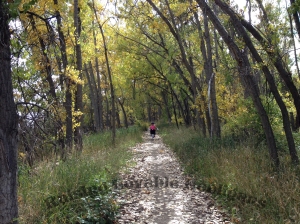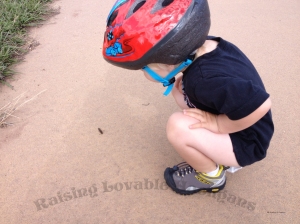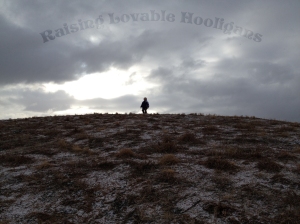Perhaps it’s because he’s my second child and the crazy obsessiveness I exhibited with my first child has left me… mostly. Perhaps it’s because I thought our little adventure wouldn’t take us very far from the car and, honestly, I really didn’t want to carry anything. I’m not sure why we started on our journey without a diaper bag but we did. And we learned an important lesson that day.
If your child drinks a lot they will require more frequent diaper changes. You’d think I would grasp this simple concept. Our son desperately wanted chocolate almond milk (it’s actually really good!). It was that “it will be the end of the world if I don’t drink chocolate almond milk right this second and my life will forever be ruined” kind of desperation. I told him that I would LOVE to give him almond milk after he finished his sippy full of water. He proceeded to take minuscule sips and then ask for milk. I proceeded to practice my patience and deep breathing.
After nap he finally caved (WaHoooo!) and downed the 10ish ounces of water. I happily changed his diaper, handed him a sippy full of this very much sought after sweet nectar of the gods (a.k.a. chocolate almond milk) and stuck him in his car seat. By the time our family arrived at Chatfield State Park the second sippy full of liquid was empty. At this point you’d think some red flags would have started popping. Buuuuuut, they didn’t.
Had this happened to my first born I probably would have calculated how long it would take the liquid to move through her system to determine how many diapers I should bring with us on our walk. Then, I probably would have added five more diapers, just in case, and placed them neatly in her diaper bag next to extra water, a bundle of healthy snacks, some educational toys, two outfits, a jacket, snow gear, rain gear, a swimsuit and whatever else I deemed necessary for a short outing in the nearby state park. But, with our son, I figured he’d be fine with 20 ounces of liquid in his system. Hmmmm.
The Jameson picnic area in Chatfield State Park is a fun space. There’s a hill on one side of the parking lot with a few picnic tables settled near the tree line. On the other side of the parking lot you can see a beautiful view of the hogback. If the day is bright and the sun high above your head, the ridge of the hogback can stand out in sharp contrast against an uninterrupted blue sky. It can look enormous and a little bit protective. It’s as if the hogback is standing in for ancient castle walls keeping enemies at a distance. If you go before a storm, when the clouds are low and the light is hazy, the hogback can look eerie. A barrier that, if crossed, could pass you through to the fantastical worlds you learn about in stories. No matter what time of day, or what type of weather, the view seems to change. This would be a wonderful spot to work on a sense journal (see Teaching Stillness)!

Heading to the trail!
If you wander into the trees you’ll discover a secluded little trail that curves along the water. It’s gorgeous and makes you forget you’re right outside of Denver. This spot is one of our favorite spots for “mountain” biking. My daughter rides a two-wheeler you’d see any other kid with, nothing fancy or expensive. Actually, the bike might be heading toward ridiculously small as we hold out just a little longer before buying her a bigger bike. After all, if your knees get bruises from hitting the handle bars that builds character! My son rides a balance bike. For those who are considering training wheels I would highly recommend looking into balance bikes. They are brilliant! These bikes will increase the heart rate of all adults involved but my 3-year-old is able to ride down hills and take turns with admirable skill. Helmets are an absolute must. Well, helmets and a splash of confidence in your offspring are both essential.
I’ve learned my kids are quite capable. My little guy has been riding for over a year, which means I’ve been frantically sucking my breath in for over a year, and he has learned so much! My silence has given him the opportunity to test and determine his own limits. Yes, he’s only three but he seems to have already recognized some limits. He slows down when he starts to go too fast. He actually gets off the bike and walks down hills that he thinks are too steep. He takes corners a little faster than I would like, but his sense of balance and speed seem to be decently honed, at least for a three-year-old. If I determined those limits for him think of all the learning that would be lost (gasp)! It’s given me ample opportunity to Keep my Parental Adrenalin In Check.

What’s up here?
So, my daughter takes off riding down dirt paths surrounded by tall grass with my son close behind. These dirt paths allow both my kids to ride on uneven, narrow terrain. They have to compensate for rocks, water, varying light, and 180 degree turns with limited visibility. They adore these rides. They enjoy the challenge, develop excellent concentration skills and certainly feel accomplished at the end of the ride. And, I get to actually walk at an adult speed.
We were certainly enjoying ourselves. The kids were laughing as they rode over bumpy parts of the path, listening to how their voices change as they sing out. My daughter pointed out different plants and asked what they were called. I had no idea as I’m not a plant person but I fear all these questions are going to force me to become a botanist. So, I took a picture for us to look up later. My son was swiveling between pointing out ants and seeing if the clouds were moving in the sky. My daughter kept asking, “I wonder what’s around that corner?” So, we would ride a little further. Further than my husband and I realized. When we began thinking of dinner, realized the time and distance we had traveled (a good reminder to be aware of your surroundings), we decided we needed to head back. We angled out of the trees and headed for the sidewalk to get back to the car a little more quickly. It was then that it happened.

Pants not required when mountain biking.
My little man started crying that his pants had water on them. Confused, I ran back to check it out and it was then I understood. The 20 ounces of liquid had returned at the most inopportune time and my son’s diaper had leaked. This diaper could not hold one more drop of pee! He wanted the pants off and he wanted them off now. And, yeah, I get that. Wet jeans are horrible. The day was chilly but not freezing. So, the pants came off. I stared in awe at his diaper but told him to hop back on his bike so we could get to the car and get him in a new diaper. And that’s how we learned that pants are not required when “mountain” biking. My husband went ahead to get the car since we were now moving unbelievably slowly. Being pant-less didn’t stop my son. He would ride for a bit, then walk his bike, then stop to look at a bug. All the while he kept up a running dialog of everything he was doing and seeing. He made me smile and laugh and reminded me that, hey, pee happens but it’s not the end of the world.

Pants not required when investigating bugs.
When you’re out in nature things are going to happen. No matter how well, or, in my case, how horribly you prepare, things will happen. And, when they do, your kids will look to you to figure out how they should handle unexpected situations. Should they become so angry they simply storm home? Should they allow their frustration to shadow the rest of the outing and ruin the mood of all involved? Do they laugh and talk about how it will be a good story? Do they adjust and adapt continuing as planned? Your response to the unexpected will help them learn how to respond to those types of situations in all areas of their life, not just outdoors. We’ve all known, or been, that person who doesn’t adjust so well when situations don’t go as we planned. So, remember, in life pants aren’t always required.
Connecting Nature and Education!
Writing and Reading – Create a nature journal for children to write about their experiences.
- Younger children: use a journal with blank pages or create your own by combining blank pages. Have your children draw a picture of your experiences outside. Once they have drawn their illustration they can dictate and you can write about their drawing/experience for them.
- Emerging young writers: use or create a journal where half of the page is blank and half is lined. Instead of using one half-and-half page you can also combine a blank page from a printer and a page with appropriately spaced lines. Have your young writer illustrate and write about their experience. When they are done writing encourage them to read it to you. If you would like you can then tell them you are going to show them how it would look if they were to see their writing in a book. Then correctly write their sentence in small letters underneath their writing.
- Young writers: encourage them to use their five senses to fully describe their experience. This is a wonderful opportunity to work on the 6+1 traits of writing. If you are not familiar with these here is a quick and easy explanation: http://educationnorthwest.org/resource/503.
I have always found that my students and my children are more enthusiastic and focused if I sit down and do an activity with them. So, grab a nature journal for yourself and sit down with your kiddos and write! Plus, if your little adventure took an unexpected turn the journal entries are bound to make you laugh. Write together, share together and grow together.
Science
Many children find the animals and/or plants they see interesting. Encourage this interest and create a nature log detailing what animals and/or plants you find along your way. Depending on your time and the interest of the children you’re working with you can have them sketch, color, paint or write about what they are tracking. Use your cell phone or a camera and take a picture of what they have drawn/written about, print off the picture and attach it to their illustration/writing. Using the picture, illustration and/or writing you can use a guide, app, or reference book to learn more about what was captured on paper.
For example, my daughter is interested in trees. She constantly asks about the trees we see in our area. When we go out to add to our tree log I have her use colored pencils or, if I’m feeling ambitious, water colors to copy the tree into our log. She then takes a picture of the entire tree, sometimes from multiple angles if she’s excited, and a close-up of the leaves or needles (you typically start by noting the shape of the tree and what the leaves or needles look like). We print off the pictures at home. She attaches the picture on the next page in her log and we use our field guide to identify what type of tree it is. There are apps out there that can help you identify trees. She writes the type of tree it is by her illustration and now she has a reference.
You can make a nature log for just about anything in nature: trees, flowers, birds, animal tracks, rocks. Use whatever your child is interested in and go out to explore.















